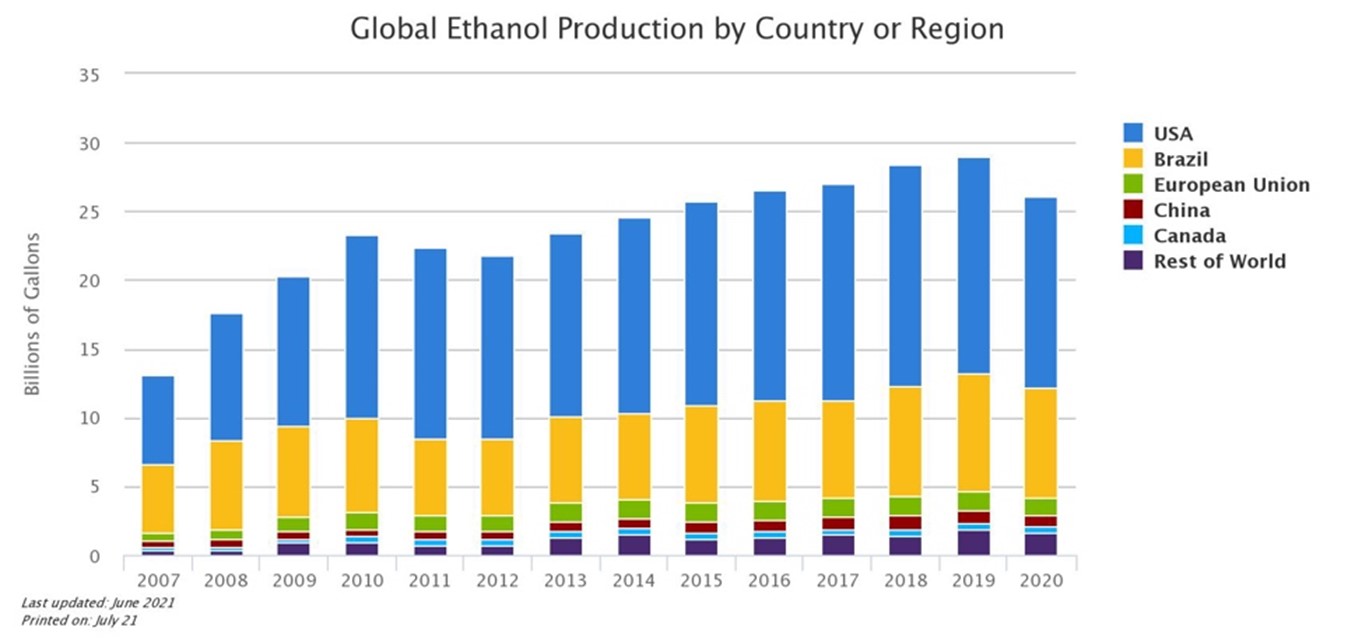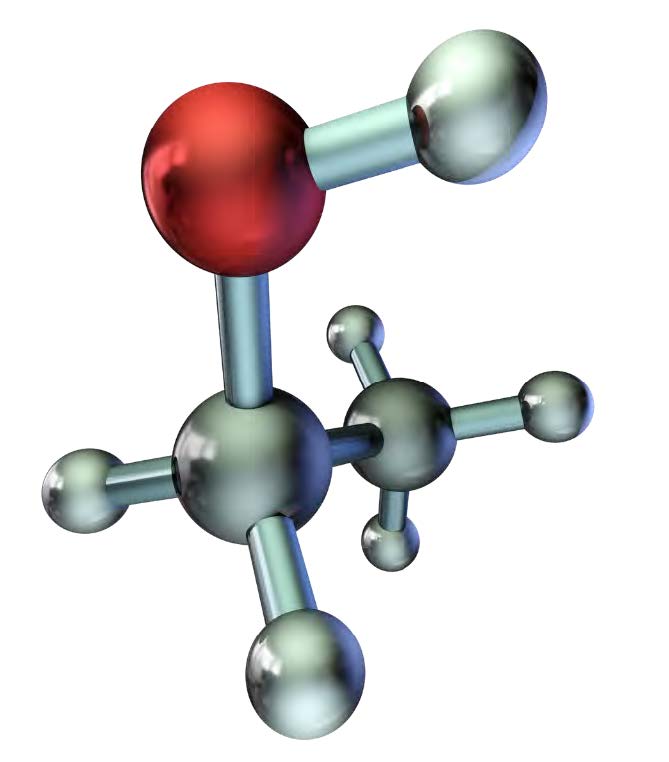
Ethanol is the most mature among major renewable fuels and has the highest global consumption, with the US and Brazil being the top two consumers. Ethanol, when blended into gasoline, oxygenates the fuel and offers a proven solution for reducing transportation-related greenhouse gas (GHG) emissions. It is a clean, cost-effective way to improve the octane of gasoline or motor fuel, helping the engines to run more efficiently. As in the case of some other biofuels like FAME, high concentrations of ethanol usage also require engine modifications.
Typical corn ethanol produced today offers a 44-52% reduction in GHG, when compared to standard gasoline. According to the US Department of Energy, more than 98% of U.S. gasoline contains ethanol – typically E10 (10% ethanol, 90% gasoline).
Ethanol feedstocks are produced from starches and sugars, such as corn grain in the United States and sugar cane in Brazil. Newer cellulosic feedstocks like wood chips or crop residues of lower carbon intensity may be preferred in the future. In addition to fueling light-duty vehicles, ethanol can also be used as a feedstock for sustainable aviation fuel (SAF) via the alcohol-to-jet (ATJ) pathway, allowing greater diversification.
The use of ethanol as a fuel generates controversy. While it supports a healthy agricultural industry, keeping the demand – and price – for grains high and boosting rural economies, many industry experts argue that replacing forests and grassland with corn fields increases the overall carbon footprint, as corn absorbs less carbon dioxide. Additionally, as global food scarcity becomes a more pressing problem, the feedstock used for ethanol might be better serviced as a source of food.

Challenges
As with any industrial process, using fermentation to convert ethanol from starch and sugar feedstock presents challenges. These include accurate monitoring of recipe calculations, tightly controlling ethanol variables, and capturing data to make informed process decisions.
In the longer term, ethanol consumption in gasoline is expected to plateau or even decline as more developed regions introduce electric vehicles into the light-duty markets. The potential banning of the sales of internal combustion engine vehicles in some regions is another downside risk.
PAC’s analyzers are the industry standard for monitoring fuel properties, to ensure the production and blending process meets specifications. Our analyzers conform to specifications like ASTM D4814, D4806, and D5798, among others. We can monitor the distillation process, ensure the ethanol concentration is within specifications, and ensure that sulfur meets the required minimums.
|
|
 |
PAC Solutions for Ethanol
Ethanol Blends (Exx)
Parameter
|
Conventional Gasoline D4814 / EN 228 (to E15)
|
DF Ethanol D4806
|
Exx Blend D5798 (E51-E83)
|
PAC Solution
|
| Distillation |
|
|
|
MicroDist, OptiDist2 + optimizer / SIMDIS OptiPMD (to E20)
|
| Ethanol Concentration |
|
|
|
OptiFuel (to E15)
|
| Sulfur |
≤ 80 ppm (unleaded) |
≤ 30 ppm
|
|
ElemeNtS
|
| HC analysis |
|
|
|
Reformulyzer (up to E85)
|
| Ethanol % |
|
≥ 92 |
|
Custom GC (D5501)
|
| Flashpoint |
≤ 15 ppm (S15) or 500 ppm (S500) |
≤ 15 ppm (S15) or 500 ppm (S500) |
|
OptiFlash
|
Quickly and accurately determine the boiling range characteristics of various commercially available fuel products and blends, light distillates, and middle distillates in process streams.
State-of-the-art solution for performing atmospheric distillation, offering the most precision and ease-of-use.
Complete range of simulated distillation analysis solutions up to 120°C.
Determine the boiling range characteristics of fuel products and ethanol blends in less than 10 minutes, using only 10 ml of sample.
Precision and portability in a top-of-the-line FT-IR fuel analyzer.
Detect total sulfur and/or total nitrogen efficiently using ultraviolet fluorescence (UVF) and chemiluminescence (CLD) in solid, liquid, gaseous materials and LPG samples.
Fast group type analysis of gasoline and gasoline blend streams using multi-dimensional gas chromatography.
Modify the AC Analytical Controls gas chromatograph to fit your specific analysis requirements.
Easy, safe, and accurate flash point determination up to 400 °C.
See PAC’s complete portfolio of solutions for gasoline:
https://www.paclp.com/lab-instruments/application/gasoline
Summary
Ethanol is an important part of the renewable fuel strategy for the United States and Brazil, helping these countries, and others, comply with environmental regulations, support long-term carbon reduction goals, and develop a stronger agricultural industry.
Worldwide fuel ethanol production climbed to over 27 billion gallons in 2021. This was an increase of roughly 900 million gallons compared to 2020.
The demand for ethanol is projected to increase over the next 15 years – until the number of electric vehicles on the road obsoletes ethanol as a fuel. As long as there is a demand for ethanol, there will be a need for instrumentation that allows producers to improve their production process, increase yields, and maximize efficiency. As the global leader in advanced analytical instruments, PAC ensures compliance to D4814, EN 288, D4806, and D5798. Our products deliver highly accurate results, use significantly less sample, and run analysis quickly.
Download our brochure on Ethanol
Please contact PAC for more information and detailed discussion
